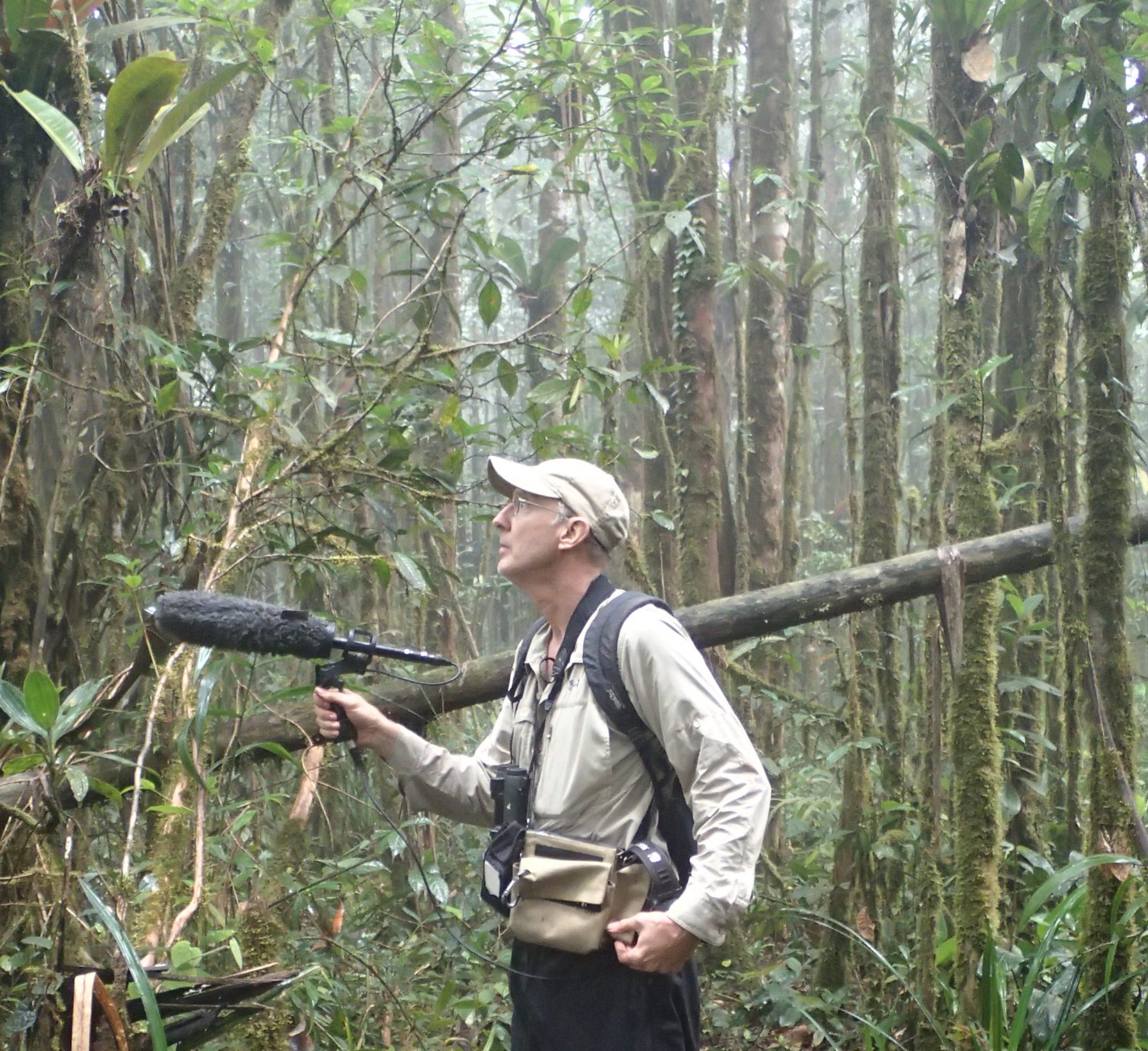Mark Robbins, the Collection Manager at the University of Kansas Biodiversity Institute, has been recording bird sounds for 40 years, mounting an unparalleled collection of sounds all of which have been archived in the Macaulay Library. Robbins now has 11,055 recordings and counting in the library—that’s nearly 3% of all of the recordings in the Macaulay Library.
Together with contemporaries such as Ted Parker, Bret Whitney, Tom Schulenberg, J. V. Remsen, and Robert Ridgely, Robbins has made significant contributions to our understanding of Neotropical birds. He has authored more than 75 scientific publications, recorded 2,500 species, and described six new bird species. Since he started recording in earnest, in 1983, he has contributed more than 100 recordings every year save for 3 years; that alone is an accomplishment that deserves recognition.
In the mid 1970s, Robbins started hanging around with several budding ornithologists including the late Ted Parker. Robbins watched Ted recording and knew right then that he needed to do the same. His first recording was of a Carolina x Black-capped Chickadee hybrid on 15 April 1978 in Vernon County, Missouri. His early recordings, along with the work of others, helped delineate the hybrid zone for Black-capped and Carolina Chickadees.

But it wasn’t until Robbins graduated from college and got his first job at the Academy of Natural Sciences in Philadelphia that he could afford his own recording equipment. In 1983, he purchased a Sony TCM-5000EV cassette recorder and a Sennheiser ME 80 microphone and headed to Colombia and beyond. Then the recordings started rolling in: a White-bearded Manakin and a Large-billed Seed-Finch in Colombia, a Black Antbird and a Dull-capped Attila in Peru, and the list goes on.
After 1983, Robbins went on one scientific expedition after another, recording previously unrecorded and new species. His enthusiasm and energy—his most defining characteristic says Tom Schulenberg, Research Associate at the Cornell lab of Ornithology, was unstoppable. On an expedition to Ecuador in 1984 he recorded and described a new species of owl, the Subtropical Pygmy-Owl (Glaucidium parkeri), which he named after Ted Parker. His research and recordings of pygmy-owls across South America helped define species limits of these owls and uncovered yet another new species of pygmy-owl, the Cloud-forest Pygmy-Owl (Glaucidium nubicola). Soon after, Robbins was back in Ecuador on another expedition, this time recording a new species of tapaculo, now named after him, the Ecuadorian Tapaculo (Scytalopus robbinsi).

Robbins laughed when I asked him about his favorite or most memorable recording. With more than 11,000 recordings, funnily enough he said he remembers the ones that got away. In 1973 in El Triunfo, Chiapas, Mexico, Robbins heard a deep humming noise that sounded like a very distance prop plane and then a Horned Guan landed in a tree on the ridge, and Robbins exclaimed “oh, I wish I had recorder for that!”
After we talked, Robbins emailed and told me about one of his favorite genera of birds—mountain-toucans. “When you listen to the Black-billed Mountain-Toucan (Andigena nigrirostris), the question becomes, is it all produced by the bill or is there some production by the syrinx. What a wonderful bird, genus, and family!”
For someone who has made so many recordings, the obvious question to ask them is, why do they record bird sounds? “Recording, Robbins says, deepens the memory. The great thing about audio recording that you’ll never get from a photograph is that when I listen to those audio recordings it gives me so much context, not only of the focal bird, but all of those background sounds, the frogs, maybe a squirrel, and there are times when the memory comes back so vividly that I feel like I can actually smell the event.”
Robbins spent a lot of time recording birds in Ecuador in forests that have been severely degraded or that no longer exist. His recordings documented what was there and may help future generations learn about how species have changed. Robbins says, “you can never predict how museum specimens might be used and that goes for digital specimens like audio recordings as well.” As the Collection Manager at the University of Kansas Biodiversity Institute, Robbins knows that collections, including digital collections such as the Macaulay Library are invaluable. “You cannot describe or put a monetary value on that (Macaulay Library) collection.”
Despite having recorded birds for more than 40 years, Robbins is as passionate as ever about recording. “I get as much of a thrill, maybe even more today than I did for the first recording,” said Robbins. Nowadays Robbins records with a Nagra Ares BB+ recorder and a Sennheiser ME 67 microphone and shows little signs of slowing down. Currently he is working on a project recording night flight calls of birds to learn more about migratory pathways. Audio recording, Robbins says, “leads down all sorts of paths.”
Robbins just returned from Australia and Tasmania and no doubt came back with a few more recordings to add to the collection. As Tom Schulenberg, at the Cornell Lab of Ornithology says, “the question isn’t how did one person contribute so much, but in Mark’s case, how much farther will he go? Mark’s dedication to field work, often under challenging conditions, is unabated,” says Schulenberg.
Robbins now has the most recordings archived at the Macaulay Library, but before our conversation ended Robbins reminded me that while he is honored to hold this distinction, “if Ted Parker was still alive, I’d be a distant second.”
Thank you Mark Robbins for your unending commitment to sound recording, the Macaulay Library, and Neotropical ornithology. We can’t wait to hear your most recent recordings.



